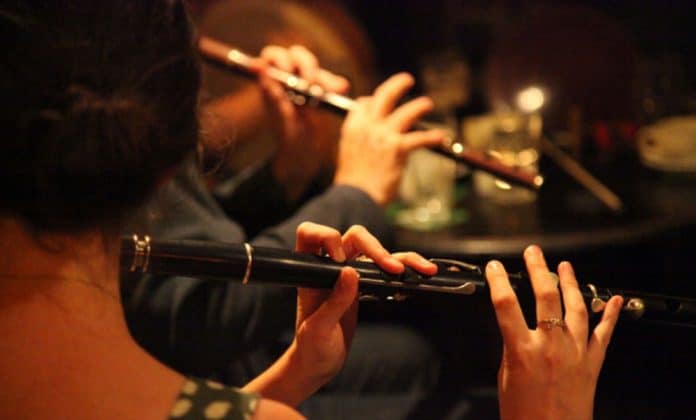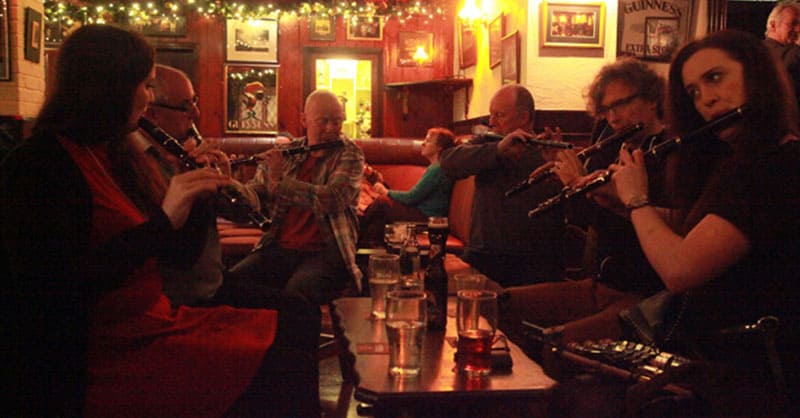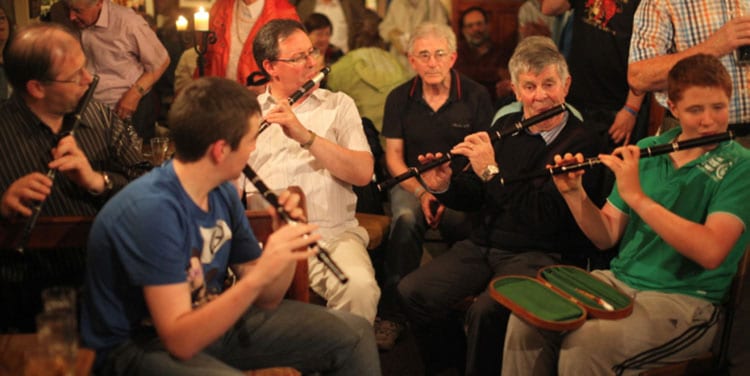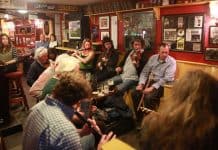
An Irish flute is generally a simple instrument crafted from wood.
It has been played across Ireland for decades in Irish Traditional Music ensembles and session style set-ups.
The instrument’s real spiritual home could be said to be towards the mid-west of the country. Particularly in the counties of Leitrim, Sligo and Roscommon, as well as East Galway, South Fermanagh, West Limerick and Clare.
This is a transverse-style wooden instrument, and it is an essential component in any Traditional Irish Music band.
Because it is made of wood, it sounds markedly different from its silver or nickel concert cousin.
The majority of Irish session flautists produce a sound that is reedier and darker when compared to a classical-style concert Boehm flute player.
History of the Irish Flute
Despite its name, it is not in fact indigenous to the country.
This instrument is a predecessor to the standard instrument that came in being in England in the the mid-1800s.
There were a number of key manufacturers of this more modern style, including the noted flautist and sometime inventor Charles Nicholson Jr, who almost totally revamped an early wooden example, improving it radically.
As the 19th century drew to a close, there were two styles in production in London: the Rudall & Rose and Boosey & Co.
The Pratten instrument had a more all-encompassing sound, whereas the Rudall & Rose ones were known for their purer sound and slighter physical construction.
Folk Tradition
Simple system wooden instruments were not produced for folk musicians. Rather, such musicians took them on and adapted them to their own needs once they had fallen out of fashion among concert flautists.
It seems likely that the military-style fife bands, which were common in Ireland during the 19th century, also played a fairly pivotal role in bringing the instrument to the attention of society in general and its great potential as a traditional Irish dance music instrument.
This fact, added to the better economic situation in Ireland as the century progressed, meant that more musicians than ever before had the means to buy one.

Contemporary Style
These days, simple system transverse wooden instruments are manufactured specifically for use in Irish Music.
Wood is still the most popular material, though other variants are made from Bamboo, Deirin and even PVC.
The instruments share a common basic design – a six-hole diatonic structure, similar to the tin whistle.
There are also several variants with different numbers of keys or, in some cases, no keys at all.
The majority are tuned in the modern style, and thus complement the more contemporary instruments in a typical Irish band.
Playing Techniques
Today’s playing techniques are very influenced by the techniques employed by tin whistle players.
The complex ornamentation is very similar, including rolls, cuts and strikes.
Playing is related to a number of Irish regions, each of which showcases distinct styles of playing.
Sligo
The classic Sligo style is a quick in tempo, ornamental and always flowing.
Possibly the most famous Sligo flautist is Matt Molloy; others include Eddie Cahill, John Joe Gardiner, Carmel Gunning and Séamus Tansey.
Leitrim
Though Leitrim is geographically very close to Sligo and is therefore overshadowed to a certain extent by the more famed style of its near neighbour, this beautiful part of Ireland has managed to retain a very clear musical tradition.
Leitrim playing is characterized by less in terms of ornamentation, is very rhythmic and involves a great deal of tonguing and glottal stops.
Fermanagh
Fermanagh style sits in both musical and geographic terms between the no-nonsense technique favoured by North East Ulster flautists and the more elaborate and ornamented approach of Leitrim and Sligo.
This is a style that was brilliantly exemplified by the late great Eddie Duffy.
East Galway
The East Galway performance is characterized by a flowing relaxed tempo – very laidback in style.

Choosing an Instrument
For those interested in learning to play this wonderful traditional instrument, you will first need to weigh up whether you want to learn on a simple wooden style or the more classical Boehm.
It’s worth noting that almost all Irish traditional flautists greatly favour the wooden style.
Looking After Your Instrument
Wooden styles need much more in the way of loving attention than their metal counterparts.
Many owners opt to regularly oil their instrument, and while opinions differ on this, carefully done it may indeed help improve its longevity.
The wooden style is very temperature-sensitive, so if it gets cold it’s best to leave it wrapped up until it has time to adjust to room temperature.
A decent case is a must, as this will protect it from temperature changes and other dangers in busy session environment and ensure this Irish Traditional Music instrument lasts for a very long time.
When you are not using it, it’s highly recommended that you keep your flute broken into its separate parts in its case – to protect the cork under the keys as much as anything else.
The wonderful flute, a pivotal instrument in Irish Traditional Music, brings something very special to the genre, whether in a session or a more formal performance.


